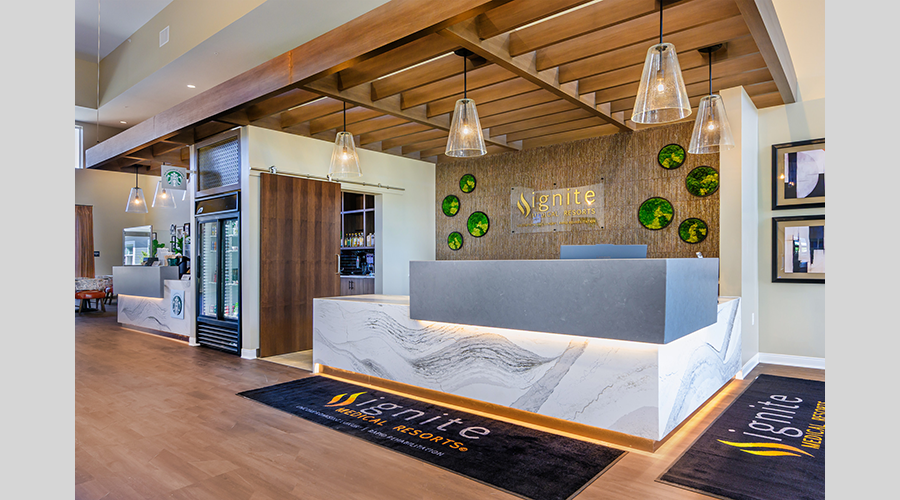In today’s evolving healthcare environment, the stakes for capital projects have never been higher. Owners and project teams are under pressure to deliver complex facilities that are safe, adaptable and cost-effective without compromising quality or patient outcomes, all while substantially shortening project timelines.
Achieving these goals requires a shift in mindset — moving from reactive problem-solving to proactive design-led strategy that supports construction. That starts with how to effectively plan and design for manufacturing and assembly (DfMA), more commonly referred to as industrialized construction or prefabrication
Design must lead the charge
Prefabrication is not a shortcut, nor is it a trend. It is a capability that only delivers value when enabled by thoughtful design. Healthcare construction projects that lead with design for manufacturing and assembly from the earliest stages of planning can unlock gains in productivity, safety, cost and quality. But to do so, designers must anticipate and enable a manufacturing mindset from day one.
This process starts with organizing around repeatability and designing for consistency, most often supported by systems standards. Building systems should be planned with assembly in mind.
Design decisions should be made with consideration for the way components will be produced, transported and installed. These considerations cannot be bolted on at the end. They must be embedded up front in design, and they include:
Value-based decision making. Not all prefabrication is valuable. Every decision should be evaluated based on the value it delivers to the project, the owner, users and long-term facility operations. That process requires clear alignment around goals and priorities.
When teams engage in value-based decision making early, they create space to explore trade-offs and maximize value. Standardization often can simplify manufacturing and speed up installation, and slight design modifications can drastically reduce field coordination. The key is to make those decisions deliberately based on what creates measurable impact.
Aligning conditions of satisfaction. To make smart, integrated decisions, design and construction teams should align on a shared definition of success. This alignment begins with setting conditions of satisfaction for a framework that defines what the project must achieve regarding safety, quality, schedule, workforce, cost and patient experience.
These criteria help project stakeholders evaluate design and delivery options through a consistent lens. Instead of making siloed decisions that optimize one variable at the expense of others, the whole team can make coordinated choices that drive overall value. Early alignment reduces risk, eliminates ambiguity and supports a collaborative culture of accountability.
Designing for off-site construction. Prefabrication should not be pursued for its own sake. Without the right design approach, off-site strategies can add complexity, cost and coordination challenges and actually reduce value and speed rather than increase it. But when design intentionally supports manufacturing, the results can be transformative.
Successful projects plan for:
- Repeatability — minimizing variation in the design to streamline production and improve quality
- Constructability — designing components and assemblies for efficient installation
- Flow — coordinating design with production sequencing and logistics
- Tracking and quality assurance — leveraging digital tools to monitor progress and performance.
The payoff can include reduced on-site labor and congestion, improved safety outcomes, reduced carbon, better quality control and create cost and schedule certainty.
Healthcare organizations looking to modernize project delivery must recognize that effective design is the foundation for innovative construction strategies. DfMA is not a tool for the back end of the process. It is a strategy that begins with design leadership. By setting clear goals and designing for manufacturing, project teams can deliver healthcare facilities that perform better, cost less and adapt more readily to future needs while substantially reducing project schedules.
Case study
At a time when healthcare systems face rising costs and heightened expectations, it is becoming clear that the best way to build better hospitals is to start by designing smarter. One leading example is UPMC Presbyterian’s new 17-story inpatient bed tower in development in Pittsburgh. When completed in late 2026, the tower will include 636 private patient rooms and more than 1 million square feet of new clinical and community space.
From the outset, the UPMC team aligned key goals — improving quality through innovation, reducing on-site congestion and maximizing construction efficiency — using collaboration and DfMA to guide the design of fully prefabricated bathrooms for each patient room, inpatient head walls, multi-trade racks, and panelized interior and exterior walls. The approach enables more than 40 percent of the bed tower to be built offsite.
The bathroom pods were intentionally designed with repeatability, manufacturability and installation in mind before the prefabrication strategy was finalized. This effort enabled 45 percent of construction labor hours to be shifted off site while improving quality, increasing safety and reducing overall costs.
Specifically, the team set up an off-site prefabrication facility less than 4 miles from the project site as a production assembly line for the bathroom pods. The pods proceed along 13 stations for the assembly of bathroom components, such as tile and grout, grab bars, accessories, plumbing and electrical. Each pod is then checked for quality control and assigned a QR code for inventory tracking. The planned delivery of the pods included seven to 15 batches per day, with a maximum of 50 pods per week.
By leading with design and making value-based decisions, the project demonstrates the way early alignment, and intentional design can turn prefabrication from a tactic into a transformative delivery strategy.
The tenets of prefabrication have been around for 100 years, from the first Model T assembly line to the post-war prefabricated housing of Levittown, Pennsylvania. But now more than ever, the building industry is truly embracing new ways to deliver projects faster, more cheaply and of a higher quality without sacrificing design excellence. DfMA is the key to finding creative ways to solve industry challenges and efficiently support healthcare organizations and the communities they serve with the productization of the built environment.
Kyle Weisman, AIA, NCARB, is a healthcare principal and national expert in lean project delivery and prefabricated construction strategies at HGA.

 The Rising Strategic Value of Owner's Reps in Healthcare
The Rising Strategic Value of Owner's Reps in Healthcare Lawrence Group Designs Pair of Ignite Medical Resorts in Missouri
Lawrence Group Designs Pair of Ignite Medical Resorts in Missouri Construction Complete for Centra Langhorne Medical Center
Construction Complete for Centra Langhorne Medical Center Making the Energy Efficiency Case to the C-Suite
Making the Energy Efficiency Case to the C-Suite How to Avoid HAIs This Flu Season
How to Avoid HAIs This Flu Season